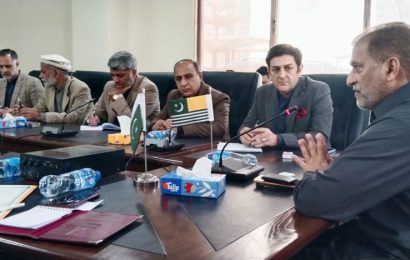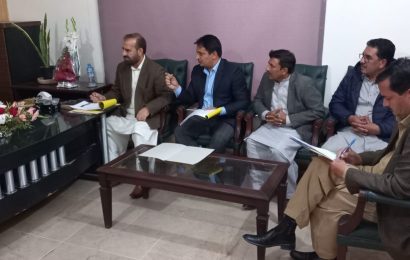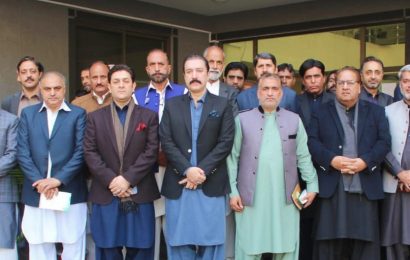Promotion of Rain Water Harvesting Project
Almost 55% water supply coverage existed in the Earthquake Affected Areas (EAAQs) of AJK and NWFP prior to earthquake of 2005. The devastating earthquake of 8th October 2005 badly affected over 4000 existing water supply schemes along with disruption of almost all water sources in this area.  About 40% decrease in the yield of water sources was also reported. To cope up with high demand of water in Earthquake Affected Areas, Earthquake Rehabilitation and Reconstruction Authority (ERRA) in the process of reconstruction and rehabilitation of affected water supply schemes on priority basis initiated Rain Water Harvesting Project to cope the water shortage. Although ERRA and Government of AJ&K completed/rehabilitated water schemes but merely rehabilitation &reconstruction of affected schemes would not be sufficient to resolve the problem of depleted water sources and would certainly not benefit the people who did not have any water supply scheme prior to earthquake. On the other hand, daily demand of water has increased exponentially because of additional water requirements for Brick & Mortar construction activities, which will continue for many years to come. As more than 90% population of EQAAs lives in a scattered manner in mountainous rural hamlets, lifting of water from main water-bodies (if available at the foot hills) or tapping water sources, situated at Kilometres distance on top of the hills may also not be a viable and cost effective solution in many areas. Due to scarcity of water sources, conservation of rain water is extremely important and rain water harvesting (RWH) is one of the best alternate and supplementary solutions. The project is to meet the goals of government policies to provide drinking water supply and sanitation facilities to every citizen. RWH is not only a starting point for efforts to meet domestic water needs, but the starting point of an effort to eradicate rural poverty itself, generate employment and most importantly address the gender issue by reducing the burden of rural women and enhancing the enrollment of girl students.
About 40% decrease in the yield of water sources was also reported. To cope up with high demand of water in Earthquake Affected Areas, Earthquake Rehabilitation and Reconstruction Authority (ERRA) in the process of reconstruction and rehabilitation of affected water supply schemes on priority basis initiated Rain Water Harvesting Project to cope the water shortage. Although ERRA and Government of AJ&K completed/rehabilitated water schemes but merely rehabilitation &reconstruction of affected schemes would not be sufficient to resolve the problem of depleted water sources and would certainly not benefit the people who did not have any water supply scheme prior to earthquake. On the other hand, daily demand of water has increased exponentially because of additional water requirements for Brick & Mortar construction activities, which will continue for many years to come. As more than 90% population of EQAAs lives in a scattered manner in mountainous rural hamlets, lifting of water from main water-bodies (if available at the foot hills) or tapping water sources, situated at Kilometres distance on top of the hills may also not be a viable and cost effective solution in many areas. Due to scarcity of water sources, conservation of rain water is extremely important and rain water harvesting (RWH) is one of the best alternate and supplementary solutions. The project is to meet the goals of government policies to provide drinking water supply and sanitation facilities to every citizen. RWH is not only a starting point for efforts to meet domestic water needs, but the starting point of an effort to eradicate rural poverty itself, generate employment and most importantly address the gender issue by reducing the burden of rural women and enhancing the enrollment of girl students.
| Project Title: | Promotion of Rain Water Harvesting (RWH) Project in Earthquake affected areas of AJK. |
| Location of Project | 11 UCs of EQAAs of AJK (Neelum=1, Mzd=3, Bagh=3, Poonch=3, Sudhnoti=1) |
| Cluster of Intervention: | Rain Water Harvesting through rooftop catchments.
|
| Total Project Budget: | Rs.495.757 million (NWFP & AJK) – AJK Share approx. 50% |
| Total Funds Requested from the ERRA: | Almost 50% of total project budget. |
| Other Funding Sources: | Beneficiary Communities |
Specific Objectives of Rain Water Harvesting.
- Store excess water for use at subsequent times.
- Improve physical and chemical quality of ground water.
- Reduce storm water run off and soil erosion.
- Increase hydrostatic pressure to prevent / stop land subsidence.
- Rehabilitate/Improve the existing traditional water harvesting structures.
- With minor scientific modifications and redesigning, convert the traditional water harvesting structures into sustainable facilities.
Rainwater harvesting is necessary in areas having significant rainfall but lacking any kind of conventional, centralized government supply system, and also in areas where good quality fresh surface water or groundwater is lacking. Collection of water in the AJK EQ affected area is predominantly from springs. Rainfall is absorbed into the soil and groundwater flows travel and fill the springs at lower elevations. No filtering of the rainwater occurs other than through the percolation of the water through the soil. Springs are abundant and are the primarily source of water. A significant proportion of houses in AJK have no access to water and more remote settlements have no springs/water sources nearby. They have to travel several miles for carrying water for domestic use.
Nature replenishes the ground water resources annually through rainfall; by way of infiltration though soil layers. Due to urbanization, the soil surface exposed to natural recharge gets reduced. Therefore, natural recharge is diminishing, resulting in drying of springs. Ground water source has the benefit of availability where water is needed and during emergencies and scarcity period, the public at large should take measure to improve the ground water recharge by rain water harvesting to maintain the reliable and sustainable ground water resource for supplementary domestic needs by ground water balance use.
Suitability .:
This proposed intervention is suitable for use in all areas as a means of augmenting the amount of water available. It is most useful in arid and semi-arid areas where other sources of water are scarce.
Advantages:
Rainwater harvesting technologies are simple to install and operate. Local people can be easily trained to implement such technologies, and construction materials are also readily available. Rainwater harvesting is convenient in the sense that it provides water at the point of consumption, and family members have full control of their own systems, which greatly reduces operation and maintenance problems. Running costs, also, are almost negligible. Water collected from roof catchments usually is of acceptable quality for domestic purposes. As it is collected using existing structures not specially constructed for the purpose, rainwater harvesting has few negative environmental impacts compared to other water supply project technologies. Although regional or other local factors can modify the local climatic conditions, rainwater can be a continuous source of water supply for both the rural and poor. Depending upon household capacity and needs, both the water collection and storage capacity may be increased as needed within the available catchments area.
Impact:
The vulnerability of target population will be reduced. Waterborne diseases under control, provide potable water to target population, prevent spread of diseases






